This Summer: Waterless World
Kelsi Dahlia throws her muscular, 5' 11" frame forward, shoulders and upper back flexing, legs thumping out a furious kick cadence, her body angled like a human javelin. She is moving with the combination of speed and power that has made her an Olympic gold medalist and America’s fastest female 100-meter butterflyer for the past five years.
She goes nowhere. There is nowhere to go.
At her house in southeast Louisville, Dahlia is confined to a nine-foot-by-12-foot portable pool —less than one-tenth as long as a lane in a 50-meter Olympic pool. A harness, attached to a curving bar hanging above, hugs her waist. This restraint allows her to swim in place, and Dahlia swims hard, water splashing overboard in all directions. The daily commotion has assuredly been a neighborhood curiosity as the 25-year-old former NCAA champion (at Louisville) became a unique member of today’s work-from-home reality.

A sport that has taken her around the globe has now been confined to a tiny rectangle in her backyard. There are no teammates here; there is no coach, no need for a stopwatch to provide the crucial metrics that differentiate a good workout from a bad one. But, also, there are no complaints. “I’m just grateful to have some water time,” Dahlia says.
As the COVID-19 pandemic squeezed off access to pools nationwide, aquatic athletes grew more desperate for alternatives—because, as the old Broadway-musical song says, fish gotta swim. There is no acceptable substitute, not for a period longer than a couple of weeks. All high-level athletes have been severely challenged by the closure of training facilities, but few (if any) as much as swimmers. From the U.S. Olympic Training Center to college campuses to municipal facilities to private clubs, the pool shutdown has been nearly universal.
The result has been a patchwork of solutions and substitutions, as many of the most recognizable names in swimming have found themselves in strange and humbling surroundings while awaiting a return to something remotely resembling normal. That normal is slowly returning for some, as pools reopen to capacities, but it will be a months-long process for most. In the meantime, the quest for water has sent the swimming diaspora out across the land—to anywhere, everywhere and nowhere.
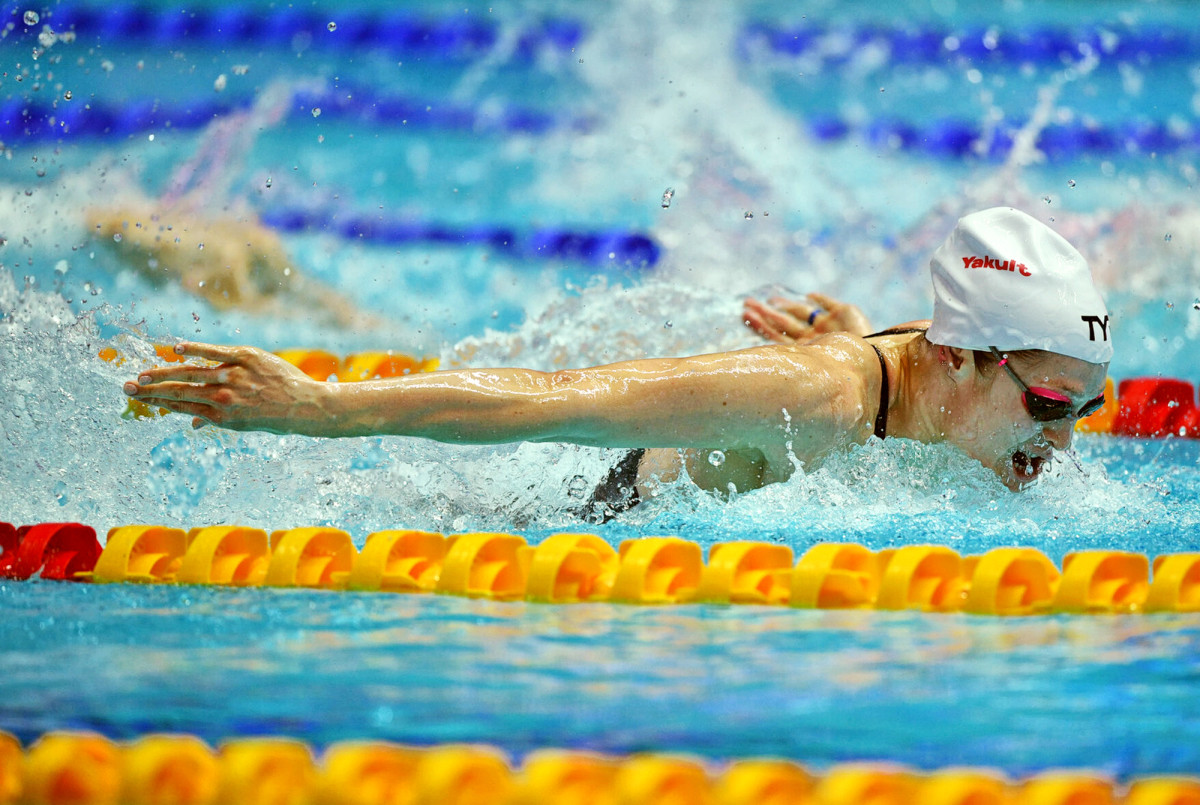
“If you spend a day out of the water,” says Dahlia, “it takes two days to get back.” When the days out of the water become weeks, swimmers start getting twitchy. Everyone exhaled when the Olympics were postponed from 2020 to ’21, because the panic of preparing for June trials momentarily evaporated. But swimmers don’t exhale for long—they’re experts at holding their breath.
They worry about any edge the competition might find. (Rumors are rampant about which prominent swimmers are in the water and which are not.) Mostly, though, they worry about losing a vague but vital property—one they struggle to define but absolutely know when it’s missing. Feel.
That’s why, on April 4, Dahlia tweeted to her followers, asking for any information that might help her in acquiring an above-ground pool. Ultimately she was referred to Fitmax, with its iPool model, and her agent quickly arranged for one to be shipped out. Now, with her pool having been up and running for nearly two months, Dahlia’s endorsement is featured at the top of Fitmax’s website.
While Dahlia burns through a short-rest workout set, her labradoodle, Kiwi, bounds around the grass. Her husband, Thomas, who leveled the ground for the pool and installed the heater that made it bearable during a chilly spring, watches from the patio. Their garage is filled with recently acquired workout equipment—an exercise bike, a squat rack, a box for box jumps, an array of dumbbells and kettlebells. When Dahlia is not toiling in the garage, she’s running or walking with Kiwi.
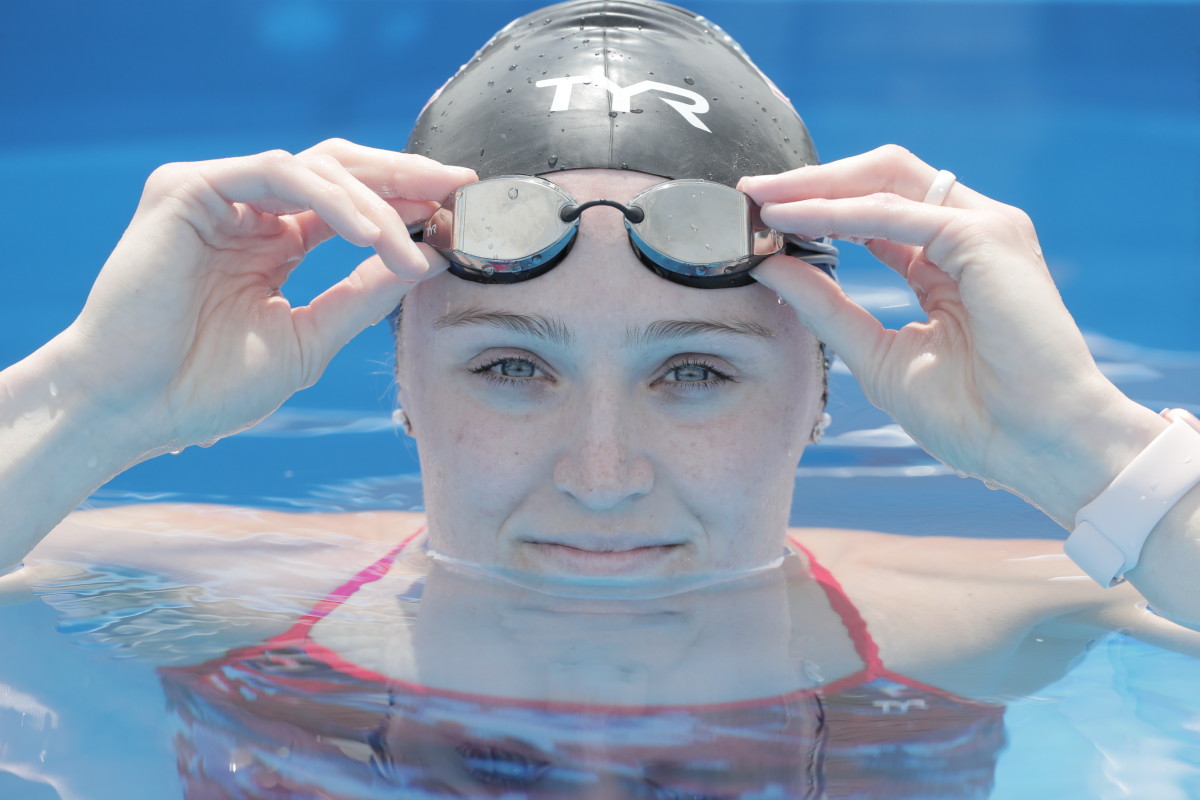
But all the dryland workouts in the world cannot replace what happens in a pool.
“It’s a little bit boring, but I throw some music on and make the best of it,” Dahlia says. “It’s almost like therapy to be able to get in the pool and get the feel for the water again.”
***
Some 110 miles north of Dahlia’s backyard pool, in Bloomington, Ind., Lilly King is timidly squishing through a muddy field in her flip-flops. There are deer tracks to her left and knee-high native grass to her right.
“Lilly’s in her element out here,” her coach, Ray Looze, says teasingly.
“I am not one with nature,” King shoots back as she tries to find a dry path toward a weedy rectangle of water.
“This is the American can-do attitude,” chortles Looze, who, like many swim coaches, loves it when the training process is flavored with some preposterous adversity.
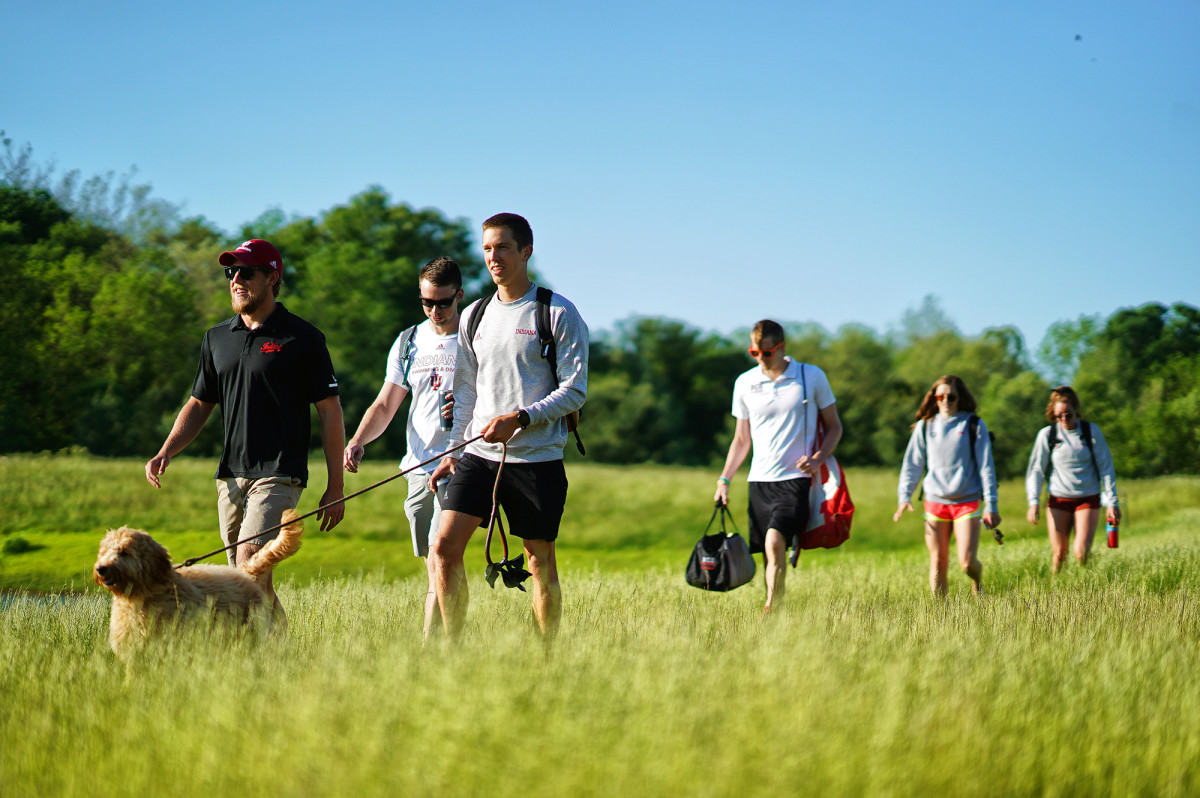
This is the final day of Pond Camp for the coach’s Indiana University pro group, a star-studded collection that includes three Olympic gold medalists, a half-dozen U.S. national team members and some Canadian standouts as well. His collective is headlined by King, the current world-record holder in the 50- and 100-meter breaststroke, who rocketed to fame in Rio four summers ago with a finger-wagging takedown of Russian rival Yulia Efimova in the 100 breast.
Worldwide, there are currently four American women at the top of the sport: Katie Ledecky in distance freestyle, Simone Manuel in sprint freestyle, teenager Regan Smith in the backstroke events, and King. Of that quartet, King came from the furthest off-radar, rising up from an obscure club program in Evansville, Ind. She’s no silver-spoon swimmer, but working out in a pond that is home to snapping turtles, croaking frogs, small fish, sprawling weeds and the occasional snake is not something she ever dreamed of doing.
“This has been a swim-to-swim sort of thing,” she says.
“I’m scared of few things,” chimes in 2016 gold medalist (and fellow IU alum) Cody Miller. “But a snapping turtle? I’m not messing with that.”
On this sun-splashed Saturday in late May, though, there are smiles all around. The pond has warmed to the point that nobody needs a wetsuit anymore. When the temperature was in the 50s, earlier in the spring, these workouts were pure misery—even with the wetsuits.
“The first time we got in, my face hurt,” says Miller. “It was freezing. You dove in and felt stuck.”
Adds breastroker Annie Lazor: “Your lungs felt like they were collapsing.”
But even a warm pond presents challenges. There are no lanes, no lines on the bottom and nothing to see beyond your own outstretched hand, which makes swimming straight difficult. Inadvertently swallowing water here is fairly disgusting. There are no walls to push off, no way to practice vital underwater turns. And whereas Dahlia had nowhere to go, the laps here extend forever—nearly twice the length of an Olympic pool.
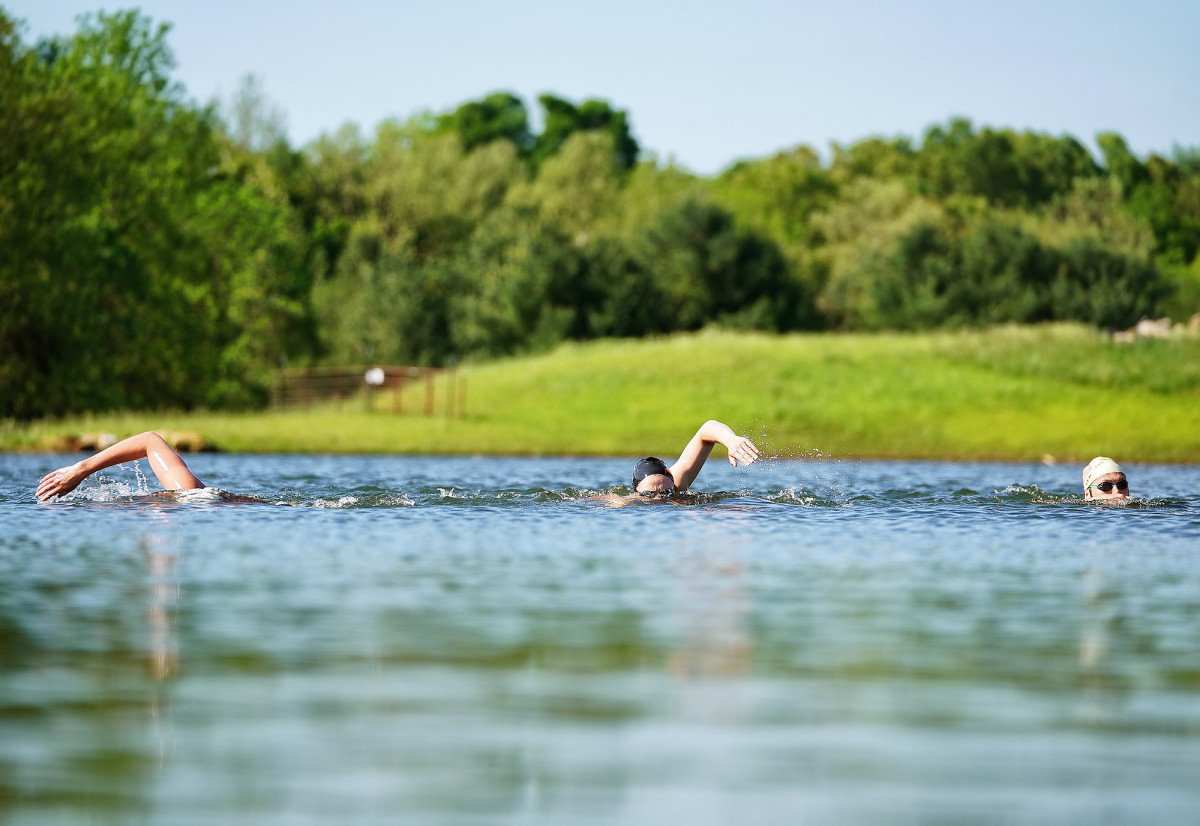
Still, the pond has had its merits. Most crucially, it has been available. A triathlete–real estate developer who knows Looze’s wife, Kandis, alerted her to its presence in a new subdivision in South Bloomington. It has a nice shape and depth, with nothing more dangerous on the bottom than some moss and weeds. The Indiana group set up buoys roughly 100 yards apart and started swimming back and forth between them.
But it’s been just one of several temporary homes for the group. When the pandemic first shut down IU’s Counsilman-Billingsley Aquatic Center, Looze started calling Bloomington-area realtors, looking for any property with a pool at least 20 yards long. There weren’t any good options, and the clock was ticking—the Tokyo 2020 Olympics had not yet been postponed.
The group’s initial Plan B was the municipal facility where King swam growing up in Evansville. But that was a two-hour drive, each way, and the roof of the pool leaked when it rained. The idea was quickly abandoned. The more permanent solution was a lap lane inside an Indianapolis home, which the IU pros used four days a week, interspersed around the pond workouts.
That indoor setup—referred to as “the Batcave”—was well appreciated but presented its own challenge. It was dark and very hot, to the point that assistant coach Cory Chitwood had to spray down the swimmers with a hose during workouts to cool their body temperatures. And it really wasn’t wide enough to accommodate multiple swimmers at the same time. “Every time you changed directions, you were fighting to reset the current,” says Miller.
The Batcave commute was also a bit of a hike, nearly 90 minutes each way, and the pool was short-course—25 yards. Just recently, a 50-meter outdoor pool opened up in Seymour, an hour away, and the group tried that for a while. “We were chasing our tails,” says Looze.
Then the coach and his wife stumbled upon a hidden gem while hiking in Martinsville, just 30 minutes away from Bloomington. They’d reached the top of a hill when they spied a pool in Jimmy Nash City Park—and it had water in it. The Loozes hurried down the hill and asked whether they could rent the lane space. It was theirs to use for free. They just had to provide their own lane lines, backstroke flags and pace clock. Done.
The swimmers’ fifth body of water will be their new home for the foreseeable future. “It’s been nuts,” says Chitwood, shaking his head. “Absolutely nuts.”
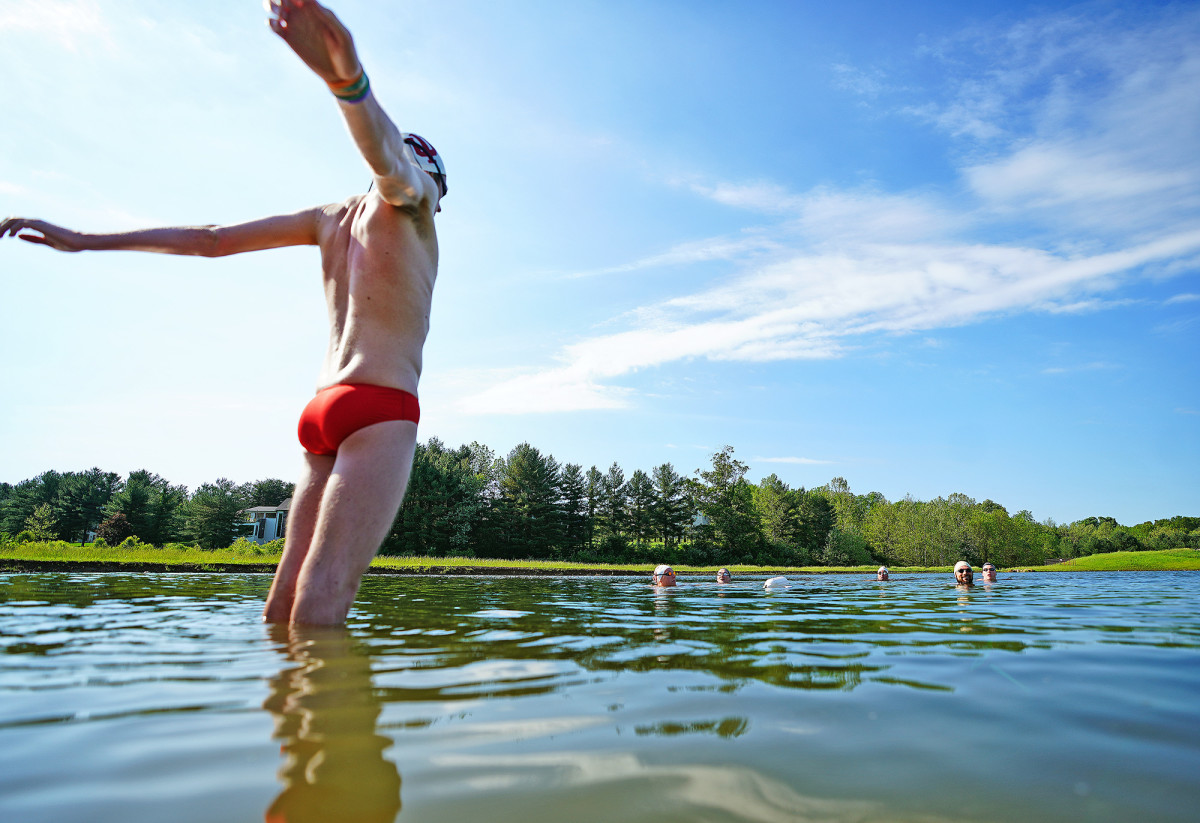
One member of the group will continue to use the pond. Zane Grothe, 28, is a freestyler on the U.S. national team at distances from 400 meters to a mile—plus open water. Unlike the others, though, Grothe finds himself at ease swimming in an unchlorinated body of water where he can’t see the bottom.
While his teammates have wandered the Hoosier state, pool to pool, he’s been in the pond every day. Grothe also constructed his own home workout system on the deck of his apartment, so he can exercise the specific muscle sets that swimmers use. Lying on a plank that extends from inside his apartment, out through a window and over his small deck, Grothe pulls weighted buckets from down below, through a set of pulleys.
For Grothe, the son of a handyman, such projects come naturally. He built a desk in college, at Auburn, and a table that now lives in his apartment. With the pools and gyms all closed, a pond and a homemade workout contraption will do well enough for him.
“You get that panicked feeling, like, I’m not swimming, so I’m falling behind,” Grothe says. “But you’ve got to remind yourself, I’m not the only one falling behind.”
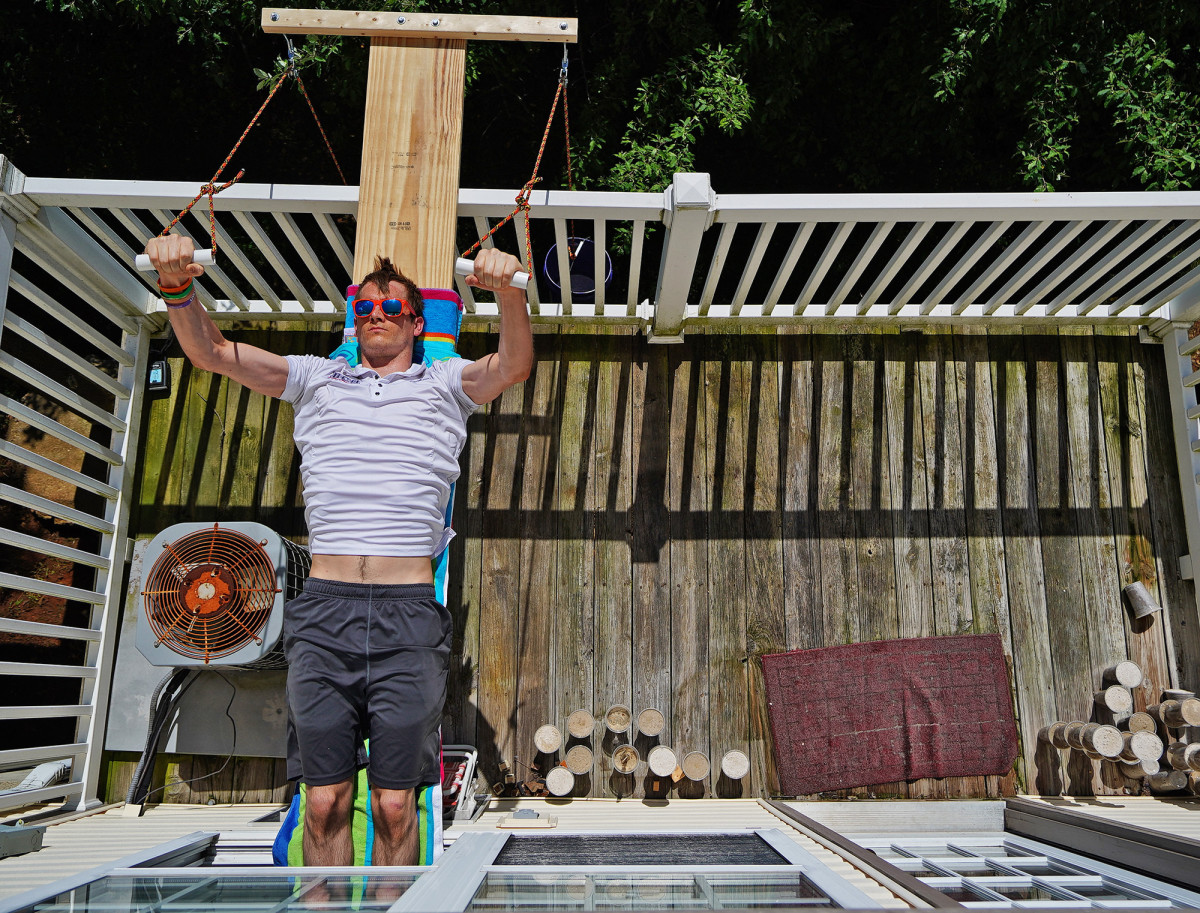
***
In March, a young entrepreneur went on ABC’s Shark Tank to sell the hosts on a business that could be summed up as Airbnb for pools. The man was Bunim Laskin, and the business was Swimply, which matches pool owners with those seeking to rent water a few hours at a time.
In the end, Laskin did not get a Shark Tank deal. But an 11-year-old in Southern California was watching, and she suggested to her grandmother that they list their 22-yard backyard lap pool on Swimply’s website. Margot Gerson followed through, thinking “nobody’s going to call.”
But they called. And called. And are still calling.
Gerson’s pool in Encinitas listed right around the time that the coronavirus started shutting everything down. Her price was a bargain: $25 an hour. Soon she was filling time slots with competitive swimmers from North Coast Aquatics and the Inland Coastal Aquatic Club; three water polo teams; and one 83-year-old man who brings her bottles of wine.
These were not 2021 Olympic aspirants. But, mid-pandemic, they were just as thirsty for training space.
“We were pretty much full through April and May, from 7 a.m. to 6 p.m.,” says Gerskn. “The swimmers brought me donuts, bread, strawberries. … They were so thankful. It’s been a total godsend, but I had to turn away so many people.”
She’s not alone. Laskin’s Swimply business is booming, with about 3,000 listings—roughly 30% of them in California, 45% on the East Coast and the rest spread throughout warm-weather locales. But the nature of the rentals has morphed since the site launched last June. Pool parties gave way to swim lessons, and now to competitive swimmers.
“We’ve shifted our entire platform,” says Laskin. “Up to 60% of our business is now for competitive swimmers.”
Fitmax, which sells the iPool that Dahlia has been using, is also doing gangbusters business. The company’s website says in bold letters that it is still taking orders—but the pools are backordered until August 20.
Elsewhere, the Michael Phelps–backed Signature Swim Spa—basically, a super-deluxe endless pool—is so expensive that its cost isn’t listed on its website. But some elite swimmers have purchased them for what they say was about $35,000.
Bottom line: If you have a useful lap pool to rent, or if you can sell a reasonable facsimile of one, congratulations. There’s a bull market the likes of which we’ve never seen. Fish gotta swim, from the up-and-coming minnows to the national team sharks.
“The greatest strength of American swimming is our depth—both athletes and coaches,” says Stanford’s women’s coach, Greg Meehan, who’s also leading the U.S. 2021 Olympic women’s team. “Even in normal times, many of [our coaches] face challenges: lack of access to long-course, 90-degree water; limited pool availability. ...
“These coaches have instilled creativity and confidence in their athletes. Things don’t always need to be perfect for them to get better or to be successful. It’s my belief that many U.S. athletes have found a way to better themselves through this pandemic. I’m not naive enough to think it’s been easy to get better, but they have … and when they return to ‘normal’ training they are set up for a successful run to Tokyo 2021.”
Meehan’s normal office is in Stanford’s Avery Aquatics Center, a sprawling palace with two 50-meter pools, a 25-yard stadium pool and a separate diving pool. It’s probably one of the five finest swimming facilities in the world. But it’s currently shut down, and now Meehan finds himself among those American coaches having to get creative. Most of his swimmers are scattered across the country while he coaches his two best, Ledecky and Manuel, in a backyard near Palo Alto.
***
Turning short-course laps behind someone’s house, tethering yourself in a micropool, paddling through a pond—none of these will get American swimmers ready for Tokyo. “This is getting us maybe 20% of where we should be,” says Looze. But this all comes back to that one thing nobody wants to lose: feel for the water.
“Swimming,” declares King, “is not like riding a bike. It’s not something you just get back in after being out and do right away and it comes back to you.”
Ask enough swimmers to define “feel for the water” and you arrive at this consensus: gaining intuitive comfort with a totally counterintuitive activity. “It’s not something humans are supposed to do,” says King.
Human beings spend almost every minute surrounded by air—upright, vertical, moving through it. Swimmers adapt themselves to constant water resistance over their entire body, while simultaneously working to avoid drowning.
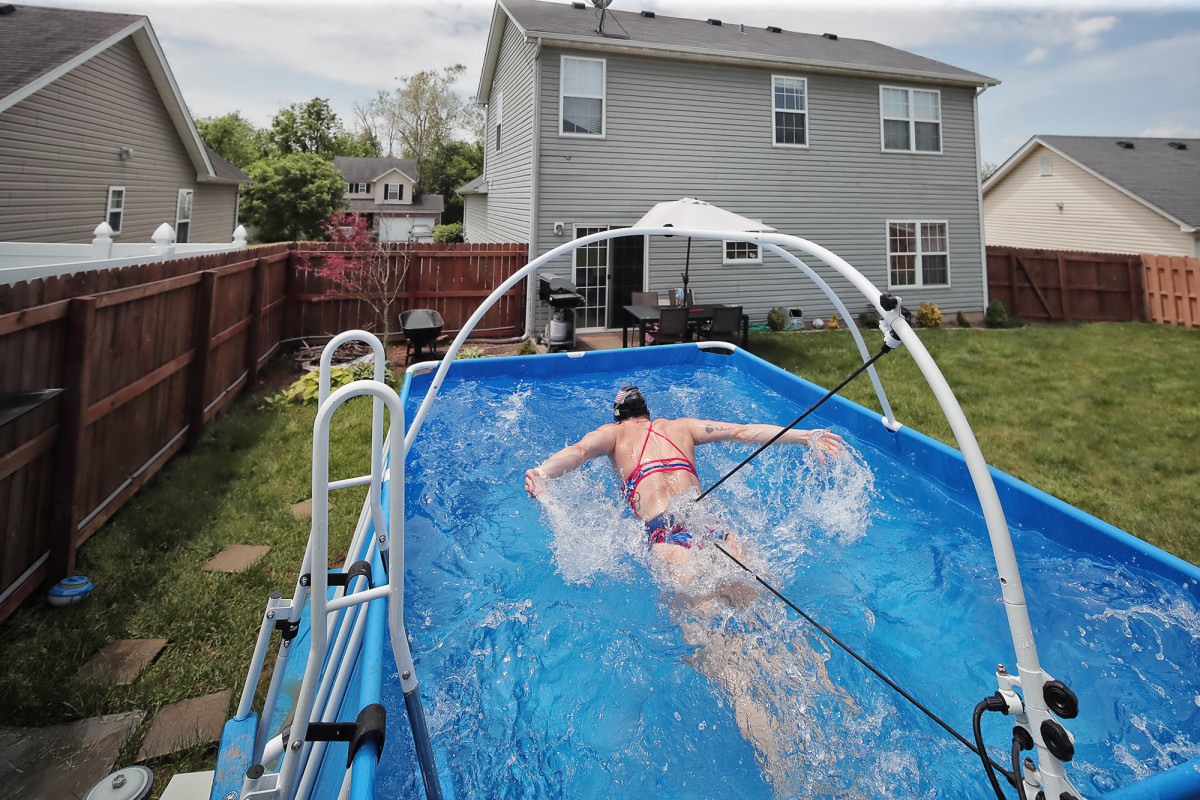
For each individual swimmer, finding the ideal body position to cut through water in the fastest and most efficient manner is the first key. Maintaining that body position—and the kinetics that go with it: hand shape, wrist bend, forearm placement, elbow position, and so on—is the key to the key. And training yourself into ridiculous cardiovascular shape to hold that technique as fatigue tries to break you down, that is the key to the key to the key.
“Swimming movements are not common,” says Thomas Dahlia, Kelsi’s husband, himself a former standout swimmer at Louisville. “You’re using muscles and doing things you never use during any other part of your day. You have to keep doing those things to maintain muscle memory.”
And so the Dahlias heat their iPool, and Kelsi buckles the harness around her waist, and attaches the resistance cords. There’s no weight room, no running track, no bike path that can accomplish what a nine-by-12 pool in the backyard can do. So away she goes, powerfully battling the water while swimming in place, training for Tokyo while not going anywhere.
